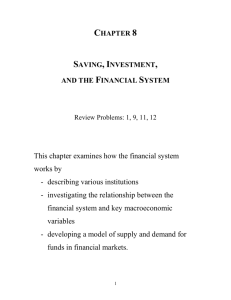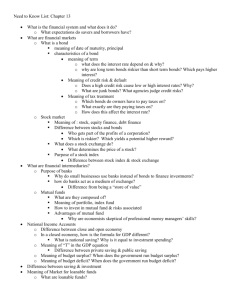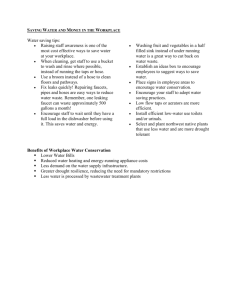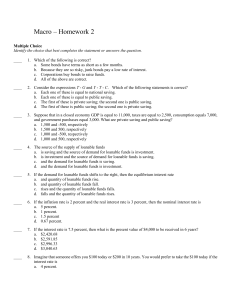chapter outline
advertisement
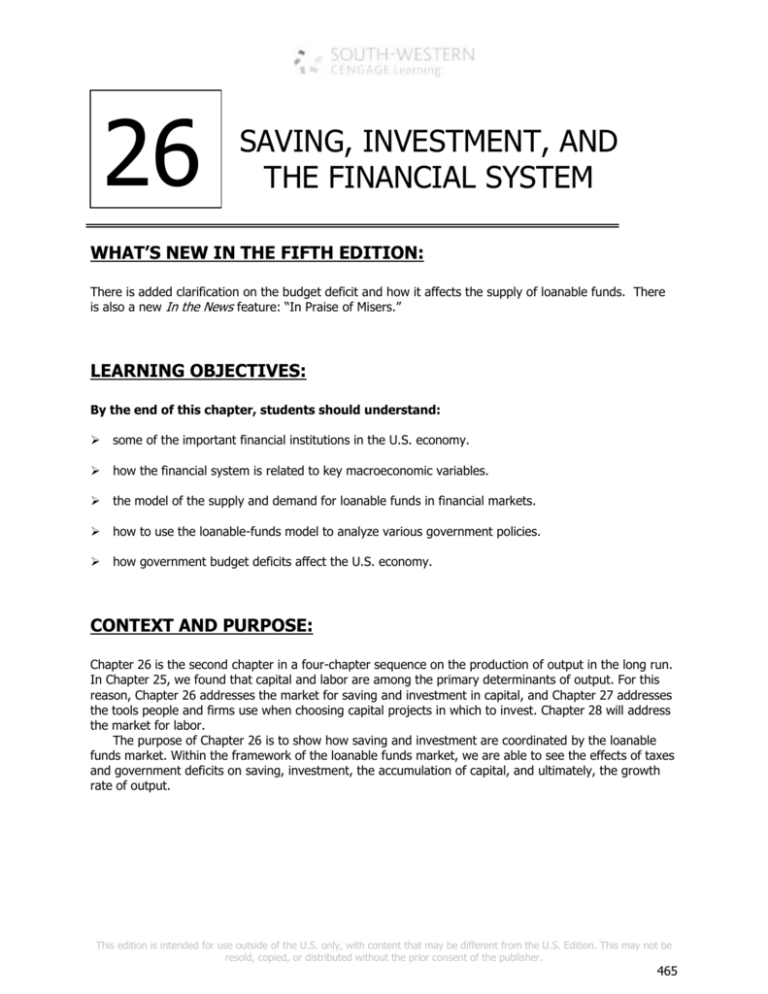
26 SAVING, INVESTMENT, AND THE FINANCIAL SYSTEM WHAT’S NEW IN THE FIFTH EDITION: There is added clarification on the budget deficit and how it affects the supply of loanable funds. There is also a new In the News feature: “In Praise of Misers.” LEARNING OBJECTIVES: By the end of this chapter, students should understand: some of the important financial institutions in the U.S. economy. how the financial system is related to key macroeconomic variables. the model of the supply and demand for loanable funds in financial markets. how to use the loanable-funds model to analyze various government policies. how government budget deficits affect the U.S. economy. CONTEXT AND PURPOSE: Chapter 26 is the second chapter in a four-chapter sequence on the production of output in the long run. In Chapter 25, we found that capital and labor are among the primary determinants of output. For this reason, Chapter 26 addresses the market for saving and investment in capital, and Chapter 27 addresses the tools people and firms use when choosing capital projects in which to invest. Chapter 28 will address the market for labor. The purpose of Chapter 26 is to show how saving and investment are coordinated by the loanable funds market. Within the framework of the loanable funds market, we are able to see the effects of taxes and government deficits on saving, investment, the accumulation of capital, and ultimately, the growth rate of output. This edition is intended for use outside of the U.S. only, with content that may be different from the U.S. Edition. This may not be resold, copied, or distributed without the prior consent of the publisher. 465 466 Chapter 26/Saving, Investment, and the Financial System KEY POINTS: The U.S. financial system is made up of many types of financial institutions, such as the bond market, the stock market, banks, and mutual funds. All of these institutions act to direct the resources of households that want to save some of their income into the hands of households and firms who want to borrow. National income accounting identities reveal some important relationships among macroeconomic variables. In particular, for a closed economy, national saving must equal investment. Financial institutions are the mechanism through which the economy matches one person’s saving with another person’s investment. The interest rate is determined by the supply and demand for loanable funds. The supply of loanable funds comes from households who want to save some of their income and lend it out. The demand for loanable funds comes from households and firms who want to borrow for investment. To analyze how any policy or event affects the interest rate, one must consider how it affects the supply and demand for loanable funds. National saving equals private saving plus public saving. A government budget deficit represents negative public saving and, therefore, reduces national saving and the supply of loanable funds available to finance investment. When a government budget deficit crowds out investment, it reduces the growth of productivity and GDP. CHAPTER OUTLINE: I. Definition of financial system: the group of institutions in the economy that help to match one person’s saving with another person’s investment. II. Financial Institutions in the U.S. Economy A. Financial Markets 1. Definition of financial markets: financial institutions through which savers can directly provide funds to borrowers. 2. The Bond Market a. Definition of bond: a certificate of indebtedness. b. A bond identifies the date of maturity and the rate of interest that will be paid periodically until the loan matures. c. One important characteristic that determines a bond’s value is its term. The term is the length of time until the bond matures. All else being equal, long-term bonds pay higher rates of interest than short-term bonds. d. Another important characteristic of a bond is its credit risk, which is the probability that the borrower will fail to pay some of the interest or principal. All else being equal, the more risky a bond is, the higher its interest rate. This edition is intended for use outside of the U.S. only, with content that may be different from the U.S. Edition. This may not be resold, copied, or distributed without the prior consent of the publisher. Chapter 26/Saving, Investment, and the Financial System 467 e. A third important characteristic of a bond is its tax treatment. For example, when state and local governments issue bonds (called municipal bonds), the interest income earned by the holders of these bonds is not taxed by the federal government. This makes the bonds more attractive, lowering the interest rate needed to entice people to buy them. 3. The Stock Market a. Definition of stock: a claim to partial ownership in a firm. b. The sale of stock to raise money is called equity finance; the sale of bonds to raise money is called debt finance. c. Stocks are sold on organized stock exchanges (such as the New York Stock Exchange or NASDAQ) and the prices of stocks are determined by supply and demand. d. The price of a stock generally reflects the perception of a company’s future profitability. e. A stock index is computed as an average of a group of stock prices. f. FYI: Key Numbers for Stock Watchers describes three key numbers that are reported on the financial pages. B. Financial Intermediaries 1. Definition of financial intermediaries: financial institutions through which savers can indirectly provide funds to borrowers. 2. Banks a. The primary role of banks is to take in deposits from people who want to save and then lend them out to others who want to borrow. b. Banks pay depositors interest on their deposits and charge borrowers a slightly higher rate of interest to cover the costs of running the bank and provide the bank owners with some amount of profit. c. Banks also play another important role in the economy by allowing individuals to use checking deposits as a medium of exchange. 3. Mutual Funds a. Definition of mutual fund: an institution that sells shares to the public and uses the proceeds to buy a portfolio of stocks and bonds. b. The primary advantage of a mutual fund is that it allows individuals with small amounts of money to diversify. c. Mutual funds called “index funds” buy all of the stocks of a given stock index. These funds have generally performed better than funds with active fund managers. This may be true because they trade stocks less frequently and they do not have to pay the salaries of fund managers. This edition is intended for use outside of the U.S. only, with content that may be different from the U.S. Edition. This may not be resold, copied, or distributed without the prior consent of the publisher. 468 Chapter 26/Saving, Investment, and the Financial System Activity 1 — Create a Portfolio Type: Topics: Class limitations: Take-home assignment Financial markets Works in any size class Purpose This assignment requires students to use the financial pages of the newspaper to create their own portfolio. Many students are unfamiliar with the basic elements of stock and bond tables. This assignment then asks students to analyze elements that would affect their portfolio. Instructions Ask the students to do the following assignment. Many possible variations exist. It can be worthwhile to have students reevaluate their portfolio at the end of the semester. 1. 2. 3. Assume you have $100,000 in savings. Create a portfolio of securities worth $100,000. Decide what financial instruments you would like to use, then find their current prices in the newspaper. Calculate your holdings of each security based on current prices. What objectives do you have for this portfolio? Was it chosen to maximize short-term gains, long-term stability, or some other objective? Explain how each of the following economic events would affect the value of your portfolio: a. an increase or decrease in interest rates b. a recession c. rapid inflation d. a depreciation of the U.S. dollar Common Answers and Points for Discussion Most students pick a mix of common stocks, mutual funds, and bonds. Some choose familiar, low-risk, but low-yielding bank accounts and certificates of deposit. A few may choose more sophisticated financial instruments. This can be used to introduce the trade-off between risk and return and the concept of the risk premium. The impact of macroeconomic events on financial markets usually interests students. Portfolios heavily invested in cyclical stocks will give low returns in the event of recession. Bonds and cash perform poorly with unanticipated inflation. Foreign-denominated assets may give high returns if the dollar depreciates. Interest rate changes can cause large swings in the value of bond-heavy portfolios. C. Summing Up 1. There are many financial institutions in the U.S. economy. 2. These institutions all serve the same goal—moving funds from savers to borrowers. III. Saving and Investment in the National Income Accounts Make sure that you work through all of the algebraic steps here. Students will not understand this material if you skip steps. This edition is intended for use outside of the U.S. only, with content that may be different from the U.S. Edition. This may not be resold, copied, or distributed without the prior consent of the publisher. Chapter 26/Saving, Investment, and the Financial System 469 A. Some Important Identities 1. Remember that GDP can be divided up into four components: consumption, investment, government purchases, and net exports. Y C I G NX 2. We will assume that we are dealing with a closed economy (an economy that does not engage in international trade or international borrowing and lending). This implies that GDP can now be divided into only three components: Y C I G 3. To isolate investment, we can subtract C and G from both sides: Y C G I 4. The left-hand side of this equation (Y – C – G ) is the total income in the economy after paying for consumption and government purchases. This amount is called national saving. 5. Definition of national saving (saving): the total income in the economy that remains after paying for consumption and government purchases. 6. Substituting saving (S) into our identity gives us: S I 7. This equation tells us that saving equals investment. 8. Let’s go back to our definition of national saving once again: S Y C G 9. We can add taxes (T) and subtract taxes (T): S (Y C T ) (T G ) 10. The first part of this equation (Y – T – C ) is called private saving; the second part (T – G ) is called public saving. a. Definition of private saving: the income that households have left after paying for taxes and consumption. b. Definition of public saving: the tax revenue that the government has left after paying for its spending. c. Definition of budget surplus: an excess of tax revenue over government spending. This edition is intended for use outside of the U.S. only, with content that may be different from the U.S. Edition. This may not be resold, copied, or distributed without the prior consent of the publisher. 470 Chapter 26/Saving, Investment, and the Financial System d. Definition of budget deficit: a shortfall of tax revenue from government spending. The important point to make here is that with a government budget deficit, public saving is negative and the public sector is thus “dissaving.” To make up for this shortfall, it must go to the loanable funds market and borrow the money. This will reduce the supply of loanable funds available for investment. 11. The fact that S = I means that (for the economy as a whole) saving must be equal to investment. a. The bond market, the stock market, banks, mutual funds, and other financial markets and institutions stand between the two sides of the S = I equation. b. These markets and institutions take in the nation's saving and direct it to the nation's investment. B. The Meaning of Saving and Investment 1. In macroeconomics, investment refers to the purchase of new capital, such as equipment or buildings. You will have to keep reminding students what the term “investment” means to macroeconomists. Outside of the economics profession, most people use the terms “saving” and “investing” interchangeably. 2. If an individual spends less than he earns and uses the rest to buy stocks or mutual funds, economists call this saving. IV. The Market for Loanable Funds A. Definition of market for loanable funds: the market in which those who want to save supply funds and those who want to borrow to invest demand funds. B. Supply and Demand for Loanable Funds Figure 1 1. The supply of loanable funds comes from those who spend less than they earn. The supply can occur directly through the purchase of some stock or bonds or indirectly through a financial intermediary. 2. The demand for loanable funds comes from households and firms who wish to borrow funds to make investments. Families generally invest in new homes while firms may borrow to purchase new equipment or to build factories. 3. The price of a loan is the interest rate. This edition is intended for use outside of the U.S. only, with content that may be different from the U.S. Edition. This may not be resold, copied, or distributed without the prior consent of the publisher. Chapter 26/Saving, Investment, and the Financial System 471 Students will wonder which interest rate is the price of a loan. Explain to them that interest rates in the economy do vary because of the things discussed earlier (term, risk, and tax treatment), but that these interest rates tend to move together when changes in the loanable funds market occur. Thus, it is appropriate to talk of one interest rate. a. All else equal, as the interest rate rises, the quantity of loanable funds supplied will increase. b. All else equal, as the interest rate rises, the quantity of loanable funds demanded will fall. Make sure that you spend time discussing why the demand for loanable funds is downward sloping and why the supply of loanable funds is upward sloping. It is important for students to understand the relationships among the interest rate, saving, and investment. 4. At equilibrium, the quantity of funds demanded is equal to the quantity of funds supplied. a. If the interest rate in the market is greater than the equilibrium rate, the quantity of funds demanded would be smaller than the quantity of funds supplied. Lenders would compete for borrowers, driving the interest rate down. b. If the interest rate in the market is less than the equilibrium rate, the quantity of funds demanded would be greater than the quantity of funds supplied. The shortage of loanable funds would encourage lenders to raise the interest rate they charge. It is a good idea to remind students that the supply of loanable funds comes from saving and the demand for loanable funds comes from investment by putting “(saving)” next to the supply curve and “(investment)” next to the demand curve as shown above. This edition is intended for use outside of the U.S. only, with content that may be different from the U.S. Edition. This may not be resold, copied, or distributed without the prior consent of the publisher. 472 Chapter 26/Saving, Investment, and the Financial System 5. The supply and demand for loanable funds depends on the real (rather than nominal) interest rate because the real rate reflects the true return to saving and the true cost of borrowing. When examining the next three sections on different policies, encourage students to follow the three-step process developed in Chapter 4. First, determine which curve is affected. Then, decide which way it shifts to determine the effects on the equilibrium interest rate and quantity of funds. C. Policy 1: Saving Incentives Figure 2 1. Savings rates in the United States are relatively low when compared with other countries such as Japan and Germany. 2. Suppose that the government changes the tax code to encourage greater saving. a. This will cause an increase in saving, shifting the supply of loanable funds to the right. b. The equilibrium interest rate will fall and the equilibrium quantity of funds will rise. 3. Thus, the result of the new tax laws would be a decrease in the equilibrium interest rate and greater saving and investment. 4. In the News: In Praise of Misers a. Increased national saving can provide important economic benefits. b. This is an opinion piece by economist Steven Landsburg defending Ebenezer Scrooge. This edition is intended for use outside of the U.S. only, with content that may be different from the U.S. Edition. This may not be resold, copied, or distributed without the prior consent of the publisher. Chapter 26/Saving, Investment, and the Financial System 473 If you would like, now would be a good time to discuss the debate in Chapter 23 concerning whether the tax laws should be reformed to encourage saving. D. Policy 2: Investment Incentives Figure 3 1. Suppose instead that the government passed a new law lowering taxes for any firm building a new factory or buying a new piece of equipment (through the use of an investment tax credit). a. This will cause an increase in investment, causing the demand for loanable funds to shift to the right. b. The equilibrium interest rate will rise, and the equilibrium quantity of funds will increase as well. 2. Thus, the result of the new tax laws would be an increase in the equilibrium interest rate and greater saving and investment. Point out that both Policy 1 (a law to increase saving) and Policy 2 (a law to increase investment) each lead to an increase in both saving and investment. the difference between these two policies lies in their effects on the interest rate. E. Policy 3: Government Budget Deficits and Surpluses Figure 4 1. A budget deficit occurs if the government spends more than it receives in tax revenue. This edition is intended for use outside of the U.S. only, with content that may be different from the U.S. Edition. This may not be resold, copied, or distributed without the prior consent of the publisher. 474 Chapter 26/Saving, Investment, and the Financial System 2. This implies that public saving (T – G) falls, which will lower national saving. a. The supply of loanable funds will shift to the left. b. The equilibrium interest rate will rise, and the equilibrium quantity of funds will decrease. 3. When the interest rate rises, the quantity of funds demanded for investment purposes falls. 4. Definition of crowding out: a decrease in investment that results from government borrowing. 5. When the government reduces national saving by running a budget deficit, the interest rate rises and investment falls. 6. Government budget surpluses work in the opposite way. The supply of loanable funds increases, the equilibrium interest rate falls, and investment rises. Now might be a good time to move to the section in Chapter 23 concerning the debate on whether or not the government should balance its budget. 7. Case Study: The History of U.S. Government Debt Figure 5 a. Figure 5 shows the debt of the U.S. government expressed as a percentage of GDP. In recent years, government debt has been about 30% to 40% of GDP. b. Throughout history, the primary cause of fluctuations in government debt has been wars. However, the U.S. debt also increased substantially during the 1980s when taxes were cut but government spending was not. This edition is intended for use outside of the U.S. only, with content that may be different from the U.S. Edition. This may not be resold, copied, or distributed without the prior consent of the publisher. Chapter 26/Saving, Investment, and the Financial System c. 475 By the late 1990s, the debt-to-GDP ratio began declining due to budget surpluses. d. The debt-to-GDP ratio began rising again during the first few years of the George W. Bush presidency. The causes have been threefold: tax cuts, a recession, and an increase in government spending for the war on terrorism. SOLUTIONS TO TEXT PROBLEMS: Quick Quizzes 1. A stock is a claim to partial ownership in a firm. A bond is a certificate of indebtedness. They are different in numerous ways: (1) a bond pays interest (a fixed payment determined when the bond is issued), while a stock pays dividends (a share of the firm’s profits that can increase if the firm is more profitable); (2) a bond has a fixed time to maturity, while a stock never matures; and (3) if a company that has issued both stock and bonds goes bankrupt, the bondholders get paid off before the stockholders, so stocks have greater risk and potentially greater return than bonds. Stocks and bonds are similar in that both are financial instruments that are used by companies to raise money for investment, both are traded on exchanges, both entail a degree of risk, and the returns to both are taxed (usually). 2. Private saving is the amount of income that households have left after paying their taxes and paying for their consumption. Public saving is the amount of tax revenue that the government has left after paying for its spending. National saving is equal to the total income in the economy that remains after paying for consumption and government purchases. Investment is the purchase of new capital, such as equipment or buildings. These terms are related in two ways: (1) National saving is the sum of public saving and private saving.. (2) In a closed economy, national saving equals investment. 3. If more Americans adopted a “live for today” approach to life, they would spend more and save less. This would shift the supply curve to the left in the market for loanable funds. At the new equilibrium, there would be less saving and investment and a higher interest rate. Questions for Review 1. The financial system's role is to help match one person's saving with another person's investment. Two markets that are part of the financial system are the bond market, through which large corporations, the federal government, or state and local governments borrow, and the stock market, through which corporations sell ownership shares. Two financial intermediaries are banks, which take in deposits and use the deposits to make loans, and mutual funds, which sell shares to the public and use the proceeds to buy a portfolio of financial assets. 2. It is important for people who own stocks and bonds to diversify their holdings because then they will have only a small stake in each asset, which reduces risk. Mutual funds make such diversification easy by allowing a small investor to purchase parts of hundreds of different stocks and bonds. This edition is intended for use outside of the U.S. only, with content that may be different from the U.S. Edition. This may not be resold, copied, or distributed without the prior consent of the publisher. 476 Chapter 26/Saving, Investment, and the Financial System 3. National saving is the amount of a nation's income that is not spent on consumption or government purchases. Private saving is the amount of income that households have left after paying their taxes and paying for their consumption. Public saving is the amount of tax revenue that the government has left after paying for its spending. The three variables are related because national saving equals private saving plus public saving. 4. Investment refers to the purchase of new capital, such as equipment or buildings. It is equal to national saving. 5. A change in the tax code that might increase private saving is the expansion of eligibility for special accounts that allow people to shelter some of their saving from taxation. This would increase the supply of loanable funds, lower interest rates, and increase investment. 6. A government budget deficit arises when the government spends more than it receives in tax revenue. Because a government budget deficit reduces national saving, it raises interest rates, reduces private investment, and thus reduces economic growth. Problems and Applications 1. The stock market does have a social purpose. Firms obtain funds for investment by issuing new stock. People are more likely to buy that stock because there are organized stock markets, so people know that they can sell their stock if they want to. 2. When the Russian government defaulted on its debt, investors perceived a higher chance of default (than they had before) on similar bonds sold by other developing countries. Thus, the supply of loanable funds shifted to the left, as shown in Figure 1. The result was an increase in the interest rate. Figure 1 This edition is intended for use outside of the U.S. only, with content that may be different from the U.S. Edition. This may not be resold, copied, or distributed without the prior consent of the publisher. Chapter 26/Saving, Investment, and the Financial System 477 3. a. The bond of an eastern European government would pay a higher interest rate than the bond of the U.S. government because there would be a greater risk of default. b. A bond that repays the principal in 2025 would pay a higher interest rate than a bond that repays the principal in 2005 because it has a longer term to maturity, so there is more risk to the principal. c. A bond from a software company you run in your garage would pay a higher interest rate than a bond from Coca-Cola because your software company has more credit risk. d. A bond issued by the federal government would pay a higher interest rate than a bond issued by New York State because an investor does not have to pay federal income tax on the bond from New York State. 4. Companies encourage their employees to hold stock in the company because it gives the employees the incentive to care about the firm’s profits, not just their own salary. Then, if employees see waste or see areas in which the firm can improve, they will take actions that benefit the company because they know the value of their stock will rise as a result. It also gives employees an additional incentive to work hard, knowing that if the firm does well, they will profit. But from an employee’s point of view, owning stock in the company for which she or he works can be risky. The employee’s wages or salary is already tied to how well the firm performs. If the firm has trouble, the employee could be laid off or have her or his salary reduced. If the employee owns stock in the firm, then there is a double whammythe employee is unemployed or gets a lower salary and the value of the stock falls as well. So owning stock in your own company is a very risky proposition. Most employees would be better off diversifyingowning stock or bonds in other companiesso their fortunes would not depend so much on the firm for which they work. 5. To a macroeconomist, saving occurs when a person’s income exceeds his consumption, while investment occurs when a person or firm purchases new capital, such as a house or business equipment. a. When your family takes out a mortgage and buys a new house, that is investment because it is a purchase of new capital. b. When you use your $200 paycheck to buy stock in AT&T, that is saving because your income of $200 is not being spent on consumption goods. c. When your roommate earns $100 and deposits it in her account at a bank, that is saving because the money is not spent on consumption goods. d. When you borrow $1,000 from a bank to buy a car to use in your pizza-delivery business, that is investment because the car is a capital good. 6. Given that Y = 8, T = 1.5, Sprivate = 0.5 = Y −T − C, Spublic = 0.2 = T − G. Because Sprivate = Y − T − C, then rearranging gives C = Y − T − Sprivate = 8 − 1.5 − 0.5 = 6. Because Spublic = T − G, then rearranging gives G = T − Spublic = 1.5 − 0.2 = 1.3. Because S = national saving = Sprivate + Spublic = 0.5 + 0.2 = 0.7. Finally, because I = investment = S, I = 0.7. This edition is intended for use outside of the U.S. only, with content that may be different from the U.S. Edition. This may not be resold, copied, or distributed without the prior consent of the publisher. 478 Chapter 26/Saving, Investment, and the Financial System 7. Private saving is equal to (Y – C – T) = 10,000 – 6,000 – 1,500 = 2,500. Public saving is equal to (T – G) = 1,500 – 1,700 = -200. National saving is equal to (Y – C – G) = 10,000 – 6,000 – 1,700 = 2,300. Investment is equal to saving = 2,300. The equilibrium interest rate is found by setting investment equal to 2,300 and solving for r: 3,300 – 100r = 2,300. 100r = 1,000. r = 10 percent. 8. a. If interest rates increase, the costs of borrowing money to build the factory become higher, so the returns from building the new plant may not be sufficient to cover the costs. Thus, higher interest rates make it less likely that Intel will build the new factory. b. Even if Intel uses its own funds to finance the factory, the rise in interest rates still matters. There is an opportunity cost on the use of the funds. Instead of investing in the factory, Intel could invest the money in the bond market to earn the higher interest rate available there. Intel will compare its potential returns from building the factory to the potential returns from the bond market. If interest rates rise, so that bond market returns rise, Intel is again less likely to invest in the factory. Figure 2 9. a. Figure 2 illustrates the effect of the $20 billion increase in government borrowing. Initially, the supply of loanable funds is curve S1, the equilibrium real interest rate is i1, and the quantity of loanable funds is L1. The increase in government borrowing by $20 billion reduces the supply of loanable funds at each interest rate by $20 billion, so the new supply curve, S2, is shown by a shift to the left of S1 by exactly $20 billion. As a result of the shift, the new equilibrium real interest rate is i2. The interest rate has increased as a result of the increase in government borrowing. This edition is intended for use outside of the U.S. only, with content that may be different from the U.S. Edition. This may not be resold, copied, or distributed without the prior consent of the publisher. Chapter 26/Saving, Investment, and the Financial System 479 b. Because the interest rate has increased, investment and national saving decline and private saving increases. The increase in government borrowing reduces public saving. From the figure you can see that total loanable funds (and thus both investment and national saving) decline by less than $20 billion, while public saving declines by $20 billion and private saving rises by less than $20 billion. c. The more elastic is the supply of loanable funds, the flatter the supply curve would be, so the interest rate would rise by less and thus national saving would fall by less, as Figure 3 shows. Figure 3 Figure 4 d. The more elastic the demand for loanable funds, the flatter the demand curve would be, so the interest rate would rise by less and thus national saving would fall by more, as Figure 4 shows. e. If households believe that greater government borrowing today implies higher taxes to pay off the government debt in the future, then people will save more so they can pay the higher future taxes. Thus, private saving will increase, as will the supply of loanable This edition is intended for use outside of the U.S. only, with content that may be different from the U.S. Edition. This may not be resold, copied, or distributed without the prior consent of the publisher. 480 Chapter 26/Saving, Investment, and the Financial System funds. This will offset the reduction in public saving, thus reducing the amount by which the equilibrium quantity of investment and national saving decline, and reducing the amount that the interest rate rises. If the rise in private saving was exactly equal to the increase in government borrowing, there would be no shift in the national saving curve, so investment, national saving, and the interest rate would all be unchanged. This is the case of Ricardian equivalence. 10. If world savings declines at the same time world investment rises, the supply curve of loanable funds shifts to the left and the demand curve shifts to the right. Figure 6 illustrates the result. The world interest rate will rise, while the overall effect on the equilibrium quantity of loanable funds is ambiguousit depends on the relative sizes of the shifts of the two curves and on their elasticities. Figure 5 11. a. Investment can be increased by reducing taxes on private saving or by reducing the government budget deficit. But reducing taxes on private saving has the effect of increasing the government budget deficit, unless some other taxes are increased or government spending is reduced. So it is difficult to engage in both policies at the same time. b. To know which of these policies would be a more effective way to raise investment, you would need to know: (1) what the elasticity of private saving is with respect to the aftertax real interest rate, because that would determine how much private saving would increase if you reduced taxes on saving; (2) how private saving responds to changes in the government budget deficit, because, for example, if Ricardian equivalence holds, the decline in the government budget deficit would be matched by an equal decline in private saving, so national saving would not increase at all; and (3) how elastic investment is with respect to the interest rate, because if investment is quite inelastic, neither policy will have much of an impact on investment. This edition is intended for use outside of the U.S. only, with content that may be different from the U.S. Edition. This may not be resold, copied, or distributed without the prior consent of the publisher.
